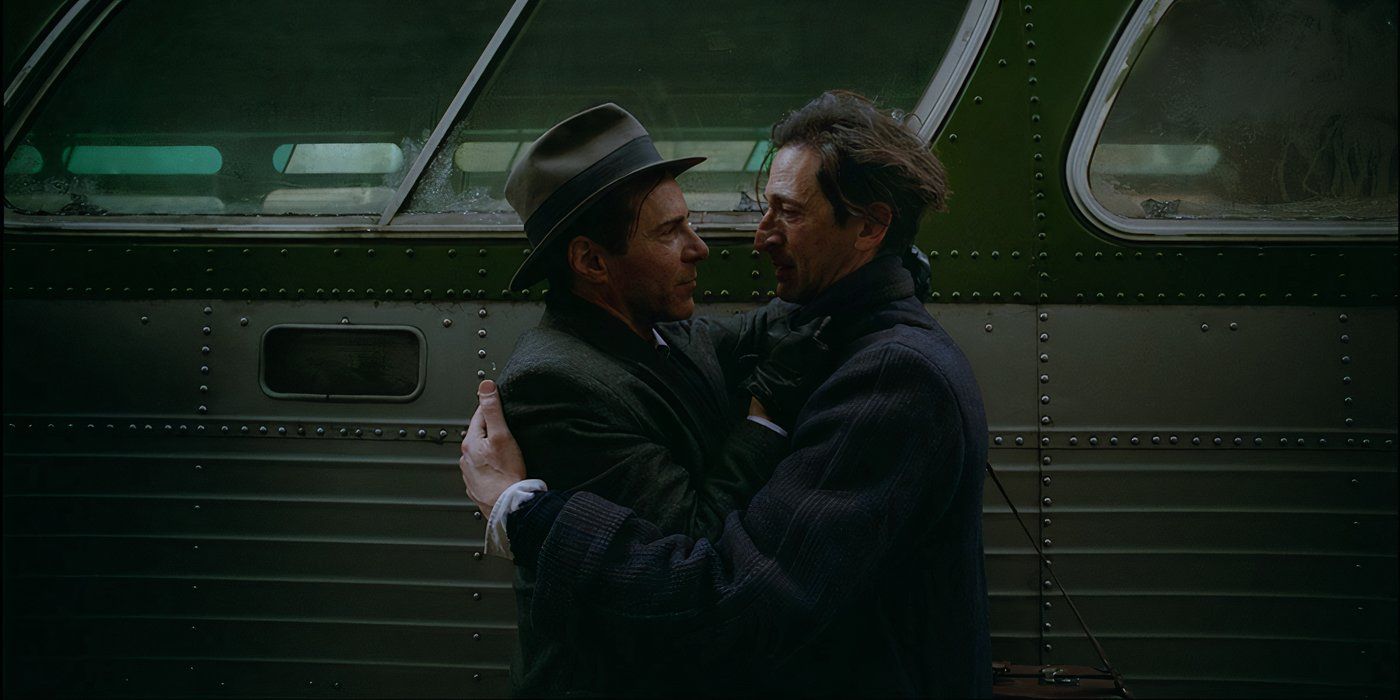I’m not someone who naturally gives preference to a film based on the size of its ambition. The filmmaking challenge of marshaling a massive production doesn’t guarantee the final product will be any more impactful as a piece of art. But there’s nothing quite like a big swing that connects, is there?
The Brutalist
is a colossal achievement, balancing intimacy and scale at every level of craft. At 3 hours, 35 minutes, it asks a lot from its viewers. Every second is well spent.
The film follows László Tóth (Adrien Brody), a Hungarian Jewish architect, from when he arrives in America after having survived the Holocaust. His experiences during the war aren’t shown to us, but represented by a scene of him in a shadowy chaos of anonymous bodies, searching for the light as a letter from his wife, Erzsébet (Felicity Jones), is read in voiceover. In it, describing her newfound liberation by the Soviet Union, she quotes Goethe: “None are more hopelessly enslaved than those who falsely believe they are free.” László emerges jubilant onto a ship’s deck, Statue of Liberty in sight.
Brody does truly delicate work for someone with the weight of the movie on his shoulders, carrying within him the complex swirl of pain and superiority that complicates his social position in his new country.
But director Brady Corbet, through disorienting tricks of perspective, shows Lady Liberty upside-down, or on her side – any way but upright. Whatever awaits László in the land of the free, the film warns us, isn’t freedom. And to salt that wound, the protagonist winds up in Philadelphia, the country’s very birthplace. His cousin Attila (Alessandro Nivola) has long since built a life there, Catholic wife and all. László can live in their storage space and design furniture for their store, with Erzsébet and his niece, Zsofia (Raffey Cassidy), still stuck in Europe.
The Brutalist Features Several Excellent Performances
But One Supporting Star Stands Out
I’m hesitant to dive too much into the story, if only because there’s so much of it, but this situation doesn’t last. László struggles for a time, enduring the indignities of underemployment and drug addiction, until Harrison Lee Van Buren (Guy Pearce) comes into his life. This wealthy, powerful man is to become his benefactor. He will fete László, pull strings with immigration for him, and ultimately employ him. He tasks the architect with a project the scale of which neither he nor Van Buren has attempted.
The unfolding of that process defines the movie at the plot level, and much of The Brutalist is a character drama. Brody does truly delicate work for someone with the weight of the movie on his shoulders, carrying within him the complex swirl of pain and superiority that complicates his social position in his new country. Jones’ fierce presence changes the energy of the second half completely, while Joe Alwyn as Harrison’s son, Harry, provides an importantly slimy contrast to his father as a result of being raised wealthy from birth.
But Pearce is undoubtedly my favorite here. He is asked to embody almost a caricature of a straight-talking, high-powered man of the ’50s, and for much of the movie, he is a reliable comedic presence. But the caricature is Harrison’s performance, not Pearce’s, and the actor takes his time peeling back the layers to his character for us. The exchanges between Harrison and László, ranging from awkward to friendly to combative, are often highlights.
A True Triumph Of Form & Style
The Brutalist is not confined by the boundaries of its characters’ lives, however. Corbet intersperses the film with video and voiceover from historical documents, including a special on Pennsylvania’s growing economy, the declaration of Israel’s independence, and a news report of the United States’ first ICBM test. These both place us in time and give historical forces a presence alongside personal ones. László’s art is their point of convergence.
At my Venice Film Festival screening, it was projected on 70mm film. Its colors are rich, expressive, and imposing at that size. If you have the chance to see it that way, jump at it.

Related
25 Best Cold War Movies Ranked
The Cold War provided a tense and intriguing backdrop for these films. Here are the best movies set during the Cold War.
We feel that synthesis long before we get to see it, or even to understand it. We learn a great deal about László’s design, but it’s not the same. Instead, the closest we get to the grandeur of what he’s chasing is communicated to us through image and music. If László carries with him his past and present, The Brutalist‘s score is the future. It’s sometimes grand, sometimes jazzy, but it’s most defined by a rhythmic churning, like the great machine of progress moving ever forward.
When played over montages that send ideas colliding, I could feel my chest swell with the certainty that something magnificent was underway. And what beautiful images they are, too. In another of The Brutalist‘s embraces of size, cinematographer Lol Crawley shot the movie in VistaVision, a widescreen format pioneered in the 1950s. At my Venice Film Festival screening, it was projected on 70mm film. Its colors are rich, expressive, and imposing at that size. If you have the chance to see it that way, jump at it.
There’s so much more I could say, and I’m sure so much more will be said as the movie’s release rolls on – especially once the ending is widely known enough to unpack it. Corbet’s film is split into labeled sections, and with both the last act and epilogue, I believe he’s managed two of the year’s best endings. I know I will be thinking about them both for some time.
The Brutalist premiered at the Venice Film Festival. The film is 215 minutes long and not yet rated.


